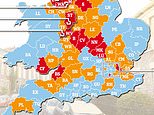An analysis of house prices, salaries and deposits every year since 1974 reveals how tough it can be for couples today to buy their first home.
House prices have surged by 2,534 per cent in the last 50 years, while salary growth has failed to keep up, the number-crunching from broker Mojo Mortgages shows.
In 1974, the average cost of a home was £10,027. Fast-forward to 2024 and the figure is £254,985 higher, at £265,012 - based on figures from Nationwide's index.
Since 1974, average individual salaries have risen by 1,791 per cent to £33,644 according to Office for National Statistics data.
However, according to Mojo's analysis, today's salaries are £13,676 short of keeping pace with house prices.
Put another way, if average house prices had risen only in line with salaries they would be £76,000 or 29 per cent cheaper than they are.
In 1974, the sum required for a deposit on a home was, the data suggests, £537. Since 1974, this has risen by 10,575 per cent to £58,303.

The average deposit as a percentage of two people's income in 1974 was 15.05 per cent, compared to 86.65 per cent this year.
However, how much deposit couples require will depend on factors like the location in question and the type and size of property being purchased.
According to the data, it takes a couple approximately 11 years to save for a deposit, compared to six months in 1974.
The average deposit saved, when taken as a percentage of the property price, was 5.36 per cent in 1974 and 22 per cent in 2024.
The age of a couple buying their first property together has risen from 26 in 1974 to 33 this year.
Inflation in 1974 was around 16 per cent, compared to 2.3 per cent currently, meaning mortgage rates were also higher then than they are now.
House prices and salaries
The data suggests that if salaries had grown at the same rate as the average house price, today's average salary would be £47,320, which is markedly higher than £33,644.
Conversely, if property prices had risen in line with sluggish salary growth, the average home would cost £189,100 this year. This is £75,912 less than today's figure.
During the 1980s, house prices tripled to £30,833, while the average joint salary rose to £13,095. The house price to income ratio improved slightly to 2.2 times, meaning the decade was generally seen as more affordable than the previous one.
By 1994, average house prices had reached £51,362, while joint incomes rose to £13,095, the research suggests.
Fast-forward to 2004 and and average property prices jumped to £147,462. However, a couple's joint salaries increased to £43,711. This prompted the house price to income ratio to spike to 3.4 times, making it tougher to get on the property ladder.
Average property prices continued to go up and, by 2014, stood at around £186,544. Joint salaries were around £54,122, pushing the affordability ratio to 2.45 times.
Mojo Mortgages added: 'Fast-forward to today, and the average home costs £265,012 compared to salaries of £33,644.
'The result is a record high house price to income ratio of 3.94 times - the steepest of the years analysed.'
John Fraser-Tucker, head of mortgages at Mojo Mortgages, told This is Money: 'Our analysis has made it clear that today’s first-time buyers are navigating a much tougher landscape than those who entered the market in 1974.'
He added: 'However, despite these daunting statistics, there’s a silver lining. First-time buyer activity is up by 21 per cent in 2024 compared to the previous year. This increase suggests that many are still finding ways to make their homeownership dreams a reality, even amid rising cost.'

Tips to buy your first home
For most people, buying their first home will be the biggest financial decision of their life, meaning it shouldn't be taken lightly.
The first step will be to figure out how much you have to spend on a property.
This will be determined by a combination of your deposit and the mortgage you can get based on your income, age, other debts and monthly outgoings.
Be aware that having a bigger deposit as a proportion of the purchase price will mean you own more of your home outright and have less to pay back overall. In theory, the bigger your deposit is, the lower your mortgage rate should be, though this may not apply for all borrowers as factors such as income and credit rating are also taken into account.
As a rough rule of thumb, most lenders typically limit people to borrowing no more than 4.5 times their annual income.
However, it can be lower dependent on any other loans and debts you may have to factor in, or potentially higher if your income and outgoings are robust.
Before you start viewing properties, it's worth getting a spreadsheet together, either with a pen and paper or online, showing how much you're likely to have to fork out for a property in total, taking all the different fees and charges into account.
Stamp duty, survey costs, legal fees, removal and potential renovation costs all need to be factored in.
It is also worth speaking to an independent mortgage broker to get an idea of how much you could borrow, and what rates might be available to you.
Fraser-Tucker, of Mojo Mortgages, said: 'First, take a close look at your finances. Understanding your saving potential and credit score can help you set realistic goals and determine what you can afford. A higher credit score unlocks better mortgage rates, making your monthly payments more manageable.
'Next, thoroughly check which Government-run schemes, such as Help to Buy or shared ownership, can benefit you if you’re struggling to save for a deposit. These programs can make homeownership more attainable.
'I’d also recommend setting a clear savings goal. Instead of simply saving what you can, create a structured plan that outlines how much you need to save each month to reach your deposit target within a reasonable timeframe. Automating your savings can simplify this process.
'Be open-minded about your search. Consider different areas or types of properties that may be more affordable than you initially thought. Sometimes expanding your criteria can uncover unexpected opportunities.'












